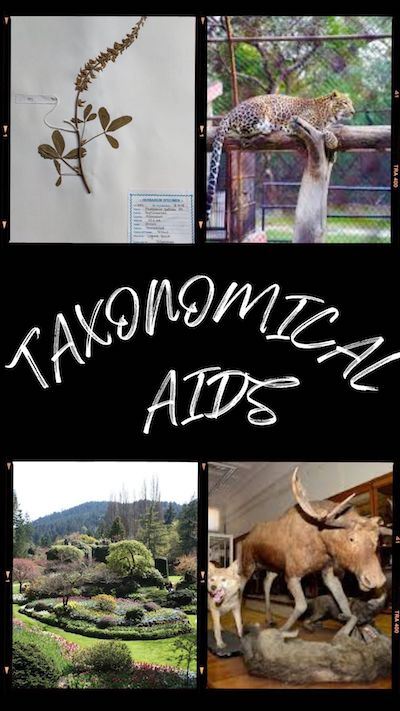“Taxonomical aids plays vital role in studying Taxonomy”
Taxonomy definition:
Taxonomy is the science of identifying, naming and classifying the living organisms. The classification of living organisms is done on the basis of physical appearance (morphology), behaviour pattern, and their genetic and chemical composition. The people who study taxonomy are called as taxonomist. The taxonomist, identify new living organism, classify and name them by following standard protocol. The taxonomy allow us to study this complex living world.
Different taxonomical aids or tools:
The tools or aids are the collection of different techniques or ways to study taxonomy. In order to conduct taxonomical studies, extensive laboratory research is required. Following are taxonomical aids –
- Herbarium
- Botanical Park
- Zoological Park
- Biodiversity Park
- Museums
- Key
- Monographs
- Flora
- Manuals
- Catalogues
Herbarium
- Herbarium is the collection of preserved plants. It is very valuable repository system.
- In order to preserve, the collected plants are dried, pressed, and preserved on standard paper sheets.
- The taxonomical aid, details of the plant like who collected the sample, when was it collected, common name, systematic names, its habitat and ecological information is mentioned on the sheet.
- The sheets in the herbarium is arranged in the order of their taxonomical hierarchy.
- The purpose of herbarium is to study diversity of plants and their evolution. They serves as educational resource for teaching staff and students.
- It allows to maintain the historical records of the plant diversity.
- It is also very useful to spread the awareness about plant diversity and its conservation.
- The detailed information about Indian Herbarium is available here.
Botanical Garden –
- Botanical Park is designed to showcase and conserve wide variety of plant species.
- The local and exotic plants are systematically and aesthetically grown in botanical parks.
- The botanical parks serves to be living classroom where biology students students can learn about them.
- Botanical park plays crucial role in conserving the threatened, rare or endangered plant species.
- The beauty of botanical garden attracts the common man and tourists and gives them an opportunity to reconnect with nature.
- They promote awareness about important of plant diversity and sustainability.
Zoological Park –
- We all know the zoological park by the name “Zoo”. It is the place, where most of kids love to visit.
- It is the facility, where the animals are kept in captivity as display for the public.
- In zoo, we try to provide them natural habitat and their basic needs are taken care of.
- The zoo plays vital role in conserving threatened and endangered species.
- In zoos, the threatened species are breed ensuring their survival.
- Zoos serves as a platform for education and awareness about wildlife and its importance in biodiversity. It creates curiosity and empathy towards the animal world.
- Zoological parks also contribute in the scientific research. In zoo, the scientists can study the animal behaviour, reproduction, nutritional requirement and their immunity.
- Zoo showcase diverse range of animals that attracts visitors and common man adding its cultural and recreational value.
Museum-
- Biological museums, the taxonomical aid are mostly found in educational institutions.
- In such museums, the small plants and animals are preserved in labelled glass jar containing formalin (10 to 40 % of formaldehyde).
- The larger animals or birds are usually stuffed and preserved. It is called as Taxidermy.
- The insects, shells and skeleton are systematically kept in boxes.
- Various large animals’ skeletons are also placed in the museum.
- Hence, the museums collect, preserved, research and showcase the diversity of life on earth.
- Such museums not only allow us to conserve the biodiversity but also to conduct research and spread awareness.
Biodiversity Park-
- Biodiversity park is the assemblage of different forms of life.
- They are established with the purpose of conserving biodiversity.
- In such parks, different species form self sustainable communities on degraded or barren land.
- They serves as the best model to study natural heritage in urban region.
- They provide the natural habitat for flora and fauna.
- Biodiversity parks provide opportunities to promote environmental education, scientific research and recreational activities..
Key:
- Keys in taxonomical aids are the systematic or structured guides consisting of parameters that help the taxonomist to identify the unknown organisms.
- The organisms are identified on the basis of the morphological characteristics or physical appearance.
- The keys consist of two contrasting character generally kept as a pair. While identifying unknown organism, one is accepted and other is rejected.
- A single pair of contracting characters is called as couplet.
- The statement in the couplet is called as Lead.
- The keys are analytical in nature that allowing us to do systematic identification of unknown organisms.
Monographs:
The monographs consist of detailed and every bit of information about particular group of organism such such genus, family or higher taxon. Such monographs are written by specialists or expert. Such detailed information is published and used as reference book. The monographs consist of existing knowledge, describing new species, revised or updated taxonomic classification, and illustrations. The monograph provide detail information about morphology, geographic, behavioural, anatomical and evolutionary information about the group.
Flora:
In taxonomy, the flora is the systematic inventory or catalogue of plant species found in particular geographical region or area. It include the information about all the plants found in that particular area. It is the comprehensive list of all plant taxa including bryophytes, ferns, gymnosperms, angiosperms and about their favourable habitat. Such Flora allows the scientists to study plant diversity of particular region.
Manuals:
The Manual is reference guidebook that provide detailed information, instructions and guidelines for identification, classification particular taxon group. Such manuals are the practical handbook used to identification of unknown organisms. The manuals has clear information and comprehensively covers the information of species, varieties, sub-species and taxa within the group. It includes description, illustration and diagnostic features of the taxon group.
Catalogues:
The catalogues are the systematic listing of organisms belonging to one taxa of same geographical region. They serve as a standard reference for further research. They provide systematic information such as scientific names, common names, synonyms and its classification and taxonomic authorities.
Dr. Sangha Bijekar has 9 years of Teaching Experience at University level. She loves to get engage in teaching and learning process. She is into blogging from last two years. She intends to provide student friendly reading material. She is avid Dog Lover and animal rescuer. She is learned Bharatnatyam and Katthak Dancer. She is into biking and She also loves to cook.


